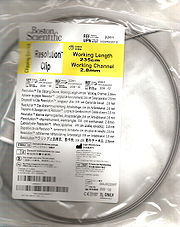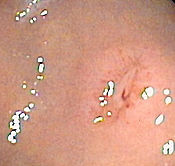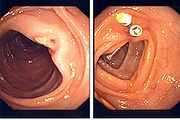
Endoclip
Encyclopedia

Endoscopy
Endoscopy means looking inside and typically refers to looking inside the body for medical reasons using an endoscope , an instrument used to examine the interior of a hollow organ or cavity of the body. Unlike most other medical imaging devices, endoscopes are inserted directly into the organ...
in order to close two mucosal surfaces without the need for surgery and suturing. Its function is similar to a suture in gross surgical applications, as it is used to join together two disjointed surfaces, but, can be applied through the channel of an endoscope under direct visualization. Endoclips have found use in treating gastrointestinal bleeding (both in the upper and lower GI tract
Lower gastrointestinal bleeding
Lower gastrointestinal bleeding, commonly abbreviated LGIB, refers to any form of bleeding in the lower gastrointestinal tract. LGIB is a common ailment seen at emergency departments. It presents less commonly than upper gastrointestinal bleeding . It is estimated that UGIB accounts for 100-200 per...
), in preventing bleeding after therapeutic procedures such as polypectomy
Polypectomy
The method used to perform colonic polypectomies during colonoscopy depends on the size, shape and histological type of the polyp to be removed. Prior to performing polypectomy, polyps can be biopsied and examined histologically to determine the need to perform polypectomy.Gastrointestinal polyps...
, and in closing gastrointestinal perforation
Gastrointestinal perforation
Gastrointestinal perforation is a complete penetration of the wall of the stomach, small intestine or large bowel, resulting in intestinal contents flowing into the abdominal cavity. Perforation of the intestines results in the potential for bacterial contamination of the abdominal cavity...
s. Many forms of endoclips exist of different shapes and sizes, including two and three prong devices, which can be administered using single use and reloadable systems, and may or may not open and close to facilitate placement.
Structure and function


Blood vessel
The blood vessels are the part of the circulatory system that transports blood throughout the body. There are three major types of blood vessels: the arteries, which carry the blood away from the heart; the capillaries, which enable the actual exchange of water and chemicals between the blood and...
s) were limited by the applicator system of the clip. However, by 1988, an easy to use applicator delivery system was developed, and a functional reloadable endoclip system was described. This consisted of a stainless steel clip (of size approximately 6 mm long and 1.2 mm wide at the prongs) with a metal deployment device (that could be used to insert the clip into the endoscopic camera, and deployed outside the camera) enclosed in a plastic sheath. These clips were initially reloadable.
Endoclips in use today have a variety of additional shapes and sizes. Clips with two and three prongs (TriClip, Cook Medical) have been described and used for various applications. Rotatable clips have been devised to improve localization of deployment. Also, clips that open and close (as opposed to single-deployment) have also been developed (Resolution Clip, Boston Scientific
Boston Scientific
The Boston Scientific Corporation , is a worldwide developer, manufacturer and marketer of medical devices whose products are used in a range of interventional medical specialties, including interventional cardiology, peripheral interventions, neuromodulation, neurovascular intervention,...
), and also facilitate the appropriate location of deployment.
When a treatable lesion is identified on endoscopy
Endoscopy
Endoscopy means looking inside and typically refers to looking inside the body for medical reasons using an endoscope , an instrument used to examine the interior of a hollow organ or cavity of the body. Unlike most other medical imaging devices, endoscopes are inserted directly into the organ...
(such as a bleeding vessel), an endoclip can be inserted through the channel of the endoscope until the sheathed clip is visible on the endoscopic image, and the handle for deployment handed to the nurse assistant. The clip is unsheathed by retraction at the handle, positioned, and "fired" by the assistant to treat the lesion.
Gastrointestinal bleeding
Endoclips have found a primary application in hemostasisHemostasis
Hemostasis or haemostasis is a process which causes bleeding to stop, meaning to keep blood within a damaged blood vessel . Most of the time this includes blood changing from a liquid to a solid state. Intact blood vessels are central to moderating blood's tendency to clot...
(or the stopping of bleeding) during endoscopy
Endoscopy
Endoscopy means looking inside and typically refers to looking inside the body for medical reasons using an endoscope , an instrument used to examine the interior of a hollow organ or cavity of the body. Unlike most other medical imaging devices, endoscopes are inserted directly into the organ...
of the upper (through gastroscopy) or lower (through colonoscopy
Colonoscopy
Colonoscopy is the endoscopic examination of the large bowel and the distal part of the small bowel with a CCD camera or a fiber optic camera on a flexible tube passed through the anus. It may provide a visual diagnosis and grants the opportunity for biopsy or removal of suspected...
) gastrointestinal tract. Many bleeding lesions have been successfully clipped, including bleeding peptic ulcers, Mallory-Weiss tears of the esophagus
Esophagus
The esophagus is an organ in vertebrates which consists of a muscular tube through which food passes from the pharynx to the stomach. During swallowing, food passes from the mouth through the pharynx into the esophagus and travels via peristalsis to the stomach...
, Dieulafoy's lesion
Dieulafoy's lesion
Dieulafoy's lesion is a medical condition characterized by a large tortuous arteriole in the stomach wall that erodes and bleeds. It can cause gastric hemorrhage but is relatively uncommon. It is thought to cause less than 5% of all gastrointestinal bleeds in adults...
s, stomach tumours
Gastrointestinal stromal tumor
A gastrointestinal stromal tumor is one of the most common mesenchymal tumors of the gastrointestinal tract...
, and bleeding after removal of polyps
Polypectomy
The method used to perform colonic polypectomies during colonoscopy depends on the size, shape and histological type of the polyp to be removed. Prior to performing polypectomy, polyps can be biopsied and examined histologically to determine the need to perform polypectomy.Gastrointestinal polyps...
. Bleeding peptic ulcers require endoscopic treatment if they show evidence of high risk stigmata of re-bleeding, such as evidence of active bleeding or oozing on endoscopy
Endoscopy
Endoscopy means looking inside and typically refers to looking inside the body for medical reasons using an endoscope , an instrument used to examine the interior of a hollow organ or cavity of the body. Unlike most other medical imaging devices, endoscopes are inserted directly into the organ...
or the presence of a visible blood vessel around the ulcer. The alternatives to endoscopic clipping of peptic ulcers are thermal therapy (such as electrocautery to burn the vessel causing the bleeding), or injection of epinephrine
Epinephrine
Epinephrine is a hormone and a neurotransmitter. It increases heart rate, constricts blood vessels, dilates air passages and participates in the fight-or-flight response of the sympathetic nervous system. In chemical terms, adrenaline is one of a group of monoamines called the catecholamines...
to constrict the blood vessel. Comparative studies between endoclips and thermal therapy make the point that endoclips cause less trauma to the mucosa around the ulcer than electrocautery, but no definitive advantage to either approach has reached consensus by gastroenterologists.
Other applications

Polypectomy
The method used to perform colonic polypectomies during colonoscopy depends on the size, shape and histological type of the polyp to be removed. Prior to performing polypectomy, polyps can be biopsied and examined histologically to determine the need to perform polypectomy.Gastrointestinal polyps...
bleeding, especially in high-risk patients or patients on anticoagulant
Anticoagulant
An anticoagulant is a substance that prevents coagulation of blood. A group of pharmaceuticals called anticoagulants can be used in vivo as a medication for thrombotic disorders. Some anticoagulants are used in medical equipment, such as test tubes, blood transfusion bags, and renal dialysis...
medications. In addition, clips can be used to close gastrointestinal perforation
Gastrointestinal perforation
Gastrointestinal perforation is a complete penetration of the wall of the stomach, small intestine or large bowel, resulting in intestinal contents flowing into the abdominal cavity. Perforation of the intestines results in the potential for bacterial contamination of the abdominal cavity...
s that may have been caused by complicated therapeutic endoscopy procedures, such as polypectomy
Polypectomy
The method used to perform colonic polypectomies during colonoscopy depends on the size, shape and histological type of the polyp to be removed. Prior to performing polypectomy, polyps can be biopsied and examined histologically to determine the need to perform polypectomy.Gastrointestinal polyps...
, or by the endoscopic procedure itself. Clips have also been used to secure the placement of endoscopic feeding tube
Feeding tube
A feeding tube is a medical device used to provide nutrition to patients who cannot obtain nutrition by swallowing. The state of being fed by a feeding tube is called gavage, enteral feeding or tube feeding...
s, and to orient the bile duct
Bile duct
A bile duct is any of a number of long tube-like structures that carry bile.Bile, required for the digestion of food, is excreted by the liver into passages that carry bile toward the hepatic duct, which joins with the cystic duct to form the common bile duct, which opens into the intestine.The...
to assist with endoscopic retrograde cholangiopancreatography
Endoscopic retrograde cholangiopancreatography
Endoscopic retrograde cholangiopancreatography is a technique that combines the use of endoscopy and fluoroscopy to diagnose and treat certain problems of the biliary or pancreatic ductal systems...
, a procedure used to image to bile duct.
Safety
Endoclips have been seen to dislodge between 1 and 3 weeks from deployment, although lengthy clip retention intervals of as high as 26 months have been reported. Endoclips are believed to be safe and no major complications (such as perforation or impaction) have been reported with them, although concern has been raised about blocking the outflow of the bile duct if clips are deployed in the duodenumDuodenum
The duodenum is the first section of the small intestine in most higher vertebrates, including mammals, reptiles, and birds. In fish, the divisions of the small intestine are not as clear and the terms anterior intestine or proximal intestine may be used instead of duodenum...
.

